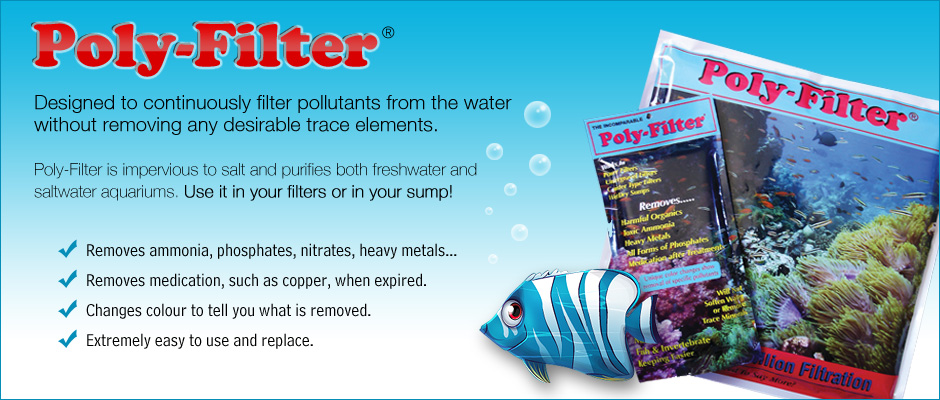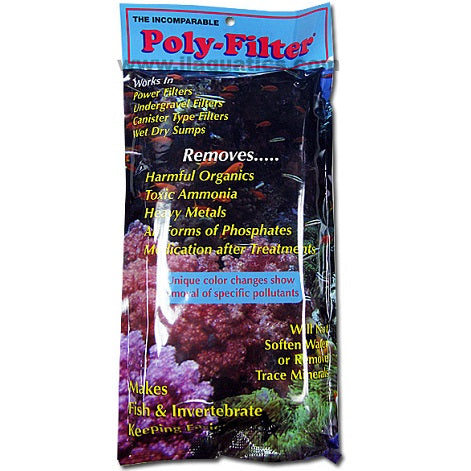An established favourite from the USA the unique Poly-Filter is now available in South Africa and is a real asset in the fight to achieve the best water quality and sparkling clarity in your aquarium. There are many chemical products that can build up in the aquarium water over time, as well as some pollutants potentially present in tap water. Poly-Filter will remove all of these chemicals including:
Poly-Filter is used for filtering and purifying both fresh and salt water aquariums. It is a formulation of a special patented material bonded to a synthetic matrix. By means of a unique proprietary process, Poly-Filter is made impervious to salt and is also organic loving to certain materials. It can absorb and adsorb contaminants and other toxic materials found in nature or added to fresh and salt water with or without fish and invertebrates. Medication added to fresh and salt water aquariums for treatment of diseased fish will automatically be removed by Poly-Filter after serving their intended purpose before the medication can produce a toxic effect on the fish.
Poly-Filter is non-toxic and harmless to biological filtration because it allows a sufficient amount of ammonia to reach the biological filter in order to sustain the bacteria culture. Poly-Filter provides a supplemental means for removal of ammonia when the biological filter is unable to break down the excess ammonia and its concentration increases rapidly. Then the POLY-FILTER adsorbs the excess ammonia while the biological filter readjusts to higher ammonia input levels.
BECAUSE OF THIS UNIQUE FILTERING CHARACTERISTIC, POLY-FILTER ELIMINATES THE NEED AND EXPENSE OF CARBON OR ION EXCHANGE RESINS AND PROTEIN SKIMMERS.
Product Information
As the pollutants are removed, the colour of the poly-filter changes, when it has turned black that is an indication that it is saturated and needs to be replaced. Unlike other substances sometimes used to aid filtration, once saturated, poly-filter will NOT allow hazardous substances to leach back into the aquarium.

Whilst removing all of the listed undesirable products, Poly Filter does NOT remove desirable trace elements and will not have a softening effect on the water, and so is equally useable in both marine and freshwater aquariums. Poly-filter can be used within any aquarium filter chamber as it can be cut to the size and shape required to fit.It can also be used in very small environments such as goldfish bowls, or Betta aquaria, by simply cutting a small piece and placing it anywhere in the water where it can be left to soak up any undesirable chemicals, until it has turned black and needs to be replaced.
Poly-Filter Maintenance
As a part of monthly maintenance, it is recommended that Poly-Filter that is used in a saltwater aquarium be rinsed in fresh water. But make sure that the fresh water used is deionized water, reverse osmosis or better yet, distilled water. This is because chlorine in plain tapwater can cause adsorbed organics in the Poly-Filter to be converted to toxic organic chemicals. Other than rinsing with distilled water to remove detritus, Poly-Filter cannot be regenerated.
Poly-Filter Placement In Marine Aquariums
If placed in the sump, the Poly-Filter pad should be placed in an area of medium to high-flow. Water should not be forced through the pad but made to flow through and around it. In the sump, the Poly-Filter pad should be placed after the protein skimmer. This is to allow the skimmer to process the raw, organic-laden water coming in from the display tank first. If you have a refugium, PolyFilter should be placed before the refugium compartment. If not, then any compartment in the sump after the protein skimmer should be fine.
On smaller tanks where a sump is not available, Poly-Filter can be placed into a media compartment of a hang-on-back power filter. It can also be placed into a canister filter, but must be cleaned at least on a weekly basis to avoid trapped detritus from causing a rise in nitrates. A layer of ordinary filter wool can be placed before the Poly-Filter pad to prevent detritus from clogging up the Poly-Filter, giving it a longer life. Better still, wrap the Poly-Filter up completely in a thin layer of filter wool. The surrounding filter wool could then be changed once a week. It is not necessary to rinse new PolyFilter before it is placed into the aquarium or sump.
Poly-Filter And Protein Skimmers
When putting a new PolyFilter pad into the aqaurium, there will be a tendency for the protein skimmer to foam excessively and even overflow, pulling in a lot of clear aquarium water. This is normal and is to be expected. It is recommended to empty out and wash the skimmer cup before placing in a new PolyFilter pad. That way, if the skimmer cup overflows, it is not returning a bunch of brown skimmate into the sump as well. Skimmer operation should return to normal after several hours.
When To Replace Poly-Filter
Poly-Filter turns dark brown when it is saturated with dissolved organics, indicating that it should be be replaced.
Why Is Poly-Filter So Expensive?
This question has been asked by every aquarium keeper who has used, or continues to use Poly-Filter on a regular basis. Apparently, Poly-Filter technology is similar to the surgical grade adsorbent filters used in dialysis machines, which could explain its price.

- Proteins and Amino Acids
- Nitrite, Nitrate and Ammonia
- Phosphates (the principal cause of algae in the aquarium)
- Toxic Metals
Poly-Filter is used for filtering and purifying both fresh and salt water aquariums. It is a formulation of a special patented material bonded to a synthetic matrix. By means of a unique proprietary process, Poly-Filter is made impervious to salt and is also organic loving to certain materials. It can absorb and adsorb contaminants and other toxic materials found in nature or added to fresh and salt water with or without fish and invertebrates. Medication added to fresh and salt water aquariums for treatment of diseased fish will automatically be removed by Poly-Filter after serving their intended purpose before the medication can produce a toxic effect on the fish.
Poly-Filter is non-toxic and harmless to biological filtration because it allows a sufficient amount of ammonia to reach the biological filter in order to sustain the bacteria culture. Poly-Filter provides a supplemental means for removal of ammonia when the biological filter is unable to break down the excess ammonia and its concentration increases rapidly. Then the POLY-FILTER adsorbs the excess ammonia while the biological filter readjusts to higher ammonia input levels.
BECAUSE OF THIS UNIQUE FILTERING CHARACTERISTIC, POLY-FILTER ELIMINATES THE NEED AND EXPENSE OF CARBON OR ION EXCHANGE RESINS AND PROTEIN SKIMMERS.
Product Information
As the pollutants are removed, the colour of the poly-filter changes, when it has turned black that is an indication that it is saturated and needs to be replaced. Unlike other substances sometimes used to aid filtration, once saturated, poly-filter will NOT allow hazardous substances to leach back into the aquarium.

Whilst removing all of the listed undesirable products, Poly Filter does NOT remove desirable trace elements and will not have a softening effect on the water, and so is equally useable in both marine and freshwater aquariums. Poly-filter can be used within any aquarium filter chamber as it can be cut to the size and shape required to fit.It can also be used in very small environments such as goldfish bowls, or Betta aquaria, by simply cutting a small piece and placing it anywhere in the water where it can be left to soak up any undesirable chemicals, until it has turned black and needs to be replaced.
Poly-Filter Maintenance
As a part of monthly maintenance, it is recommended that Poly-Filter that is used in a saltwater aquarium be rinsed in fresh water. But make sure that the fresh water used is deionized water, reverse osmosis or better yet, distilled water. This is because chlorine in plain tapwater can cause adsorbed organics in the Poly-Filter to be converted to toxic organic chemicals. Other than rinsing with distilled water to remove detritus, Poly-Filter cannot be regenerated.
Poly-Filter Placement In Marine Aquariums
If placed in the sump, the Poly-Filter pad should be placed in an area of medium to high-flow. Water should not be forced through the pad but made to flow through and around it. In the sump, the Poly-Filter pad should be placed after the protein skimmer. This is to allow the skimmer to process the raw, organic-laden water coming in from the display tank first. If you have a refugium, PolyFilter should be placed before the refugium compartment. If not, then any compartment in the sump after the protein skimmer should be fine.
On smaller tanks where a sump is not available, Poly-Filter can be placed into a media compartment of a hang-on-back power filter. It can also be placed into a canister filter, but must be cleaned at least on a weekly basis to avoid trapped detritus from causing a rise in nitrates. A layer of ordinary filter wool can be placed before the Poly-Filter pad to prevent detritus from clogging up the Poly-Filter, giving it a longer life. Better still, wrap the Poly-Filter up completely in a thin layer of filter wool. The surrounding filter wool could then be changed once a week. It is not necessary to rinse new PolyFilter before it is placed into the aquarium or sump.
Poly-Filter And Protein Skimmers
When putting a new PolyFilter pad into the aqaurium, there will be a tendency for the protein skimmer to foam excessively and even overflow, pulling in a lot of clear aquarium water. This is normal and is to be expected. It is recommended to empty out and wash the skimmer cup before placing in a new PolyFilter pad. That way, if the skimmer cup overflows, it is not returning a bunch of brown skimmate into the sump as well. Skimmer operation should return to normal after several hours.
When To Replace Poly-Filter
Poly-Filter turns dark brown when it is saturated with dissolved organics, indicating that it should be be replaced.
Why Is Poly-Filter So Expensive?
This question has been asked by every aquarium keeper who has used, or continues to use Poly-Filter on a regular basis. Apparently, Poly-Filter technology is similar to the surgical grade adsorbent filters used in dialysis machines, which could explain its price.


